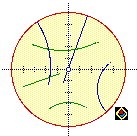
| As in Euclidean geometry, we have segments and rays as well as lines: a segment (green in the sketch) is that part of a line between two points (its endpoints), while a ray (blue) is that part of a line between a point (its initial point) and an edgepoint. There are Segment and Ray tools in the Toolbox to construct these. |  |
Once we have segments, we can talk about triangles, quadrilaterals and other polygons: the definitions are direct analogues to their Euclidean counterparts (a triangle, for example, has three points as vertices and the segments they determine as sides). But a word of caution: specific types of polygons may not exist in the Poincaré universe: without parallelism, for example, what is a parallelogram?